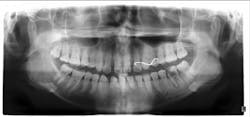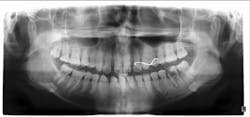Rolling in the deep
By Paul Feuerstein, DMD
The old "watch" doesn't hold up anymore. This goes back to the G. V. Black ideas of "wait until it is big enough to fill" (with amalgam, the choice material of the time) and the mantra of "extension for prevention" that has contributed to the large number of teeth today that fracture and are in need of crowns.
When a catch is found where the radiography does not help determine the extent, digital devices are helpful. We can look at some minimally invasive procedure or look at some new chemistry such as Tri-Calcium Phosphate (TCP) (3M), Recaldent (casein phosphopeptide and amorphous calcium phosphate) that appears in sealants, pastes such as GC America's MI Paste Plus, products such as VOCO's Remin Pro, and even restorative materials.
On the other hand, we sometimes spot a huge lesion (with or without digital help) when the patient has no symptoms ("Hey, Doc, it's not bothering me so why worry?"), and we go in with trepidation hoping to avoid an exposure or go right into endo.
In the "old days," we were told to use calcium hydroxide in deep lesions and even on direct exposures. The new dentinal bridge was going to form and save the day. As we have seen, this was not a total success. Some new science and materials have emerged, and there are a number of new "dentin building" bases that have appeared. The most popular are Biodentine (Septodont), TheraCal LC (BISCO), and Calcimol LC (VOCO).
Biodentine is the most diverse of these products, and can be used not only in direct exposures, but in furcation perforations, resorption cases, apexification, and apical surgery. It is similar to MTA paste, but possesses many more characteristics. It is a "bioactive calcium silicate," and in the case of a base, sets hard and seals tightly so it can withstand etching and compression of the final restoration.
The mixing and placement protocol has to be carefully observed, and there is a long setting time after trituration. In some cases, it is recommended to fill the entire prep with Biodentine, leave it, and go away to return weeks later to cut into the top and finalize the restoration. You will regret the fact that you slept through biochemistry in dental school when you read the 22-plus studies. Complete information is at septodontusa.com.
TheraCal LC from BISCO is a "resin modified calcium silicate," but it comes in a syringe, is placed at the base of the cavity, and is then light cured. BISCO's research shows that the "calcium release stimulates hydroxyapatite and secondary dentin bridge formation." There is much information, including technique videos at bisco.com.
VOCO has recently joined in this arena with Calcimol LC. This light-cured, resin-modified calcium ion is said to promote hydroxyapatite and secondary dentin growth. This is also introduced into the cavity via a syringe. But VOCO has designed what the company calls NDT – Non Dripping Technology. There are actually two plungers inside the syringe causing a "back-suction," so you get a precise amount delivered each time. Details are at voco.com.
Recently, two other products with new "bioactive" chemistry have come to dentistry that also release calcium ions. Doxa has new cement called Ceramir. Back to our chemistry lesson. It is a calcium aluminate/glass ionomer, self-etching hybrid. Not only does it have superior handling, cleanup, and luting properties, the calcium ions form hydroxyapatite inside the restoration as well as at the margins to create a true biological insoluble seal. The margins with the cement interface will continue calcium uptake to enhance the seal. More information is at ceramirus.com.
Pulpdent has also just introduced some new products in the same arena. The company has debuted the ACTIVA brand of base/liner, as well as restorative. This is new technology, expanding on the bases mentioned previously. But ACTIVA interacts with the oral environment on a continuous basis. In Pulpdent's words, the "bioactive materials are moisture-friendly, interact with saliva and tooth structure, release and uptake calcium, phosphate and more fluoride than glass ionomers, and react to changes in the oral environment." See more at pulpdent.com.
Can we really have a predictable pulp cap and new dentinal bridges? Is microleakage going to be a thing of the past with Ceramir and ACTIVA? Get out those old biochemistry books so you can help make some new clinical decisions.
Paul Feuerstein, DMD, installed one of dentistry's first computers in 1978, teaching and writing about technology since then, while practicing general dentistry in North Billerica, Massachusetts. He maintains a website (computersindentistry.com), Facebook page (Paul-Feuerstein-DMD-Dental-Technology), is on Twitter (@drpaulf), and can be reached via email at [email protected].


